 W
WB1 is a medical-based Paralympic classification for blind sport. Athletes in this classification are totally or almost totally blind. It is used by a number of blind sports including blind tennis, para-alpine skiing, para-Nordic skiing, blind cricket, blind golf, five-a-side football, goalball and judo. Some other sports, including adaptive rowing, athletics and swimming, have equivalents to this class.
 W
WB2 is a medical based Paralympic classification for blind sport. Competitors in this classification have vision that falls between the B1 and B3 classes. The International Blind Sports Federation (IBSA) defines this classification as "visual acuity ranging from LogMAR 1.50 to 2.60 (inclusive) and/or visual field constricted to a diameter of less than 10 degrees." It is used by a number of blind sports including para-alpine skiing, para-Nordic skiing, blind cricket, blind golf, five-a-side football, goalball and judo. Some sports, including adaptive rowing, athletics and swimming, have equivalents to this class.
 W
WB3 is a medical based Paralympic classification for blind sport. Competitors in this classification have partial sight, with visual acuity from 2/60 to 6/60. It is used by a number of blind sports including para-alpine skiing, para-Nordic skiing, blind cricket, blind golf, five-a-side football, goalball and judo. Some other sports, including adaptive rowing, athletics and swimming, have equivalents to this class.
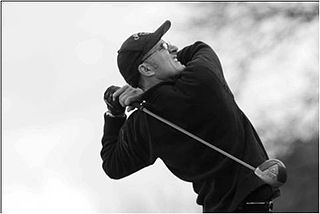 W
WDisability golf classification is used for deaf golf, blind golf, amputee golf, golf for the mentally challenged, paraplegic golf and other forms of golf involving the disabled.
 W
WBowls classification is the classification system for lawn bowls where players with a disability are classified into different categories based on their disability type. Classifications exist for blind bowlers. Bowls was played at the Paralympics and is a core sport of Commonwealth Games.
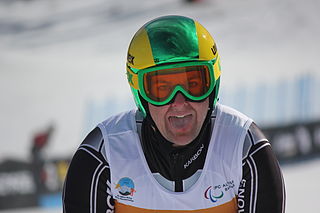 W
WLW1 is a para-Alpine standing skiing classification for people with severe lower extreme disabilities in both extremities. It includes both skiers with amputations and cerebral palsy. International classification is done through International Paralympic Committee Alpine Skiing, and national classification through local national sport federations. LW1 classified skiers use outriggers, and two skis or one ski with a prosthesis. Other equipment is used during training such as ski-tips, ski-bras, and short skis.
 W
WLW2 is a para-Alpine and para-Nordic standing ski sport class defined by the International Paralympic Committee (IPC). Competitors in this class have severe disability in a lower limb, which may be a result of an amputation, or arthrodesis in the leg and hip. Depending on the type of skiing, the international classification process for LW2 skiers is handled by the IPC Alpine Skiing Technical Committee and IPC Nordic Skiing Technical Committee. National sport federations handle classification on the lower levels.
 W
WLW10 is a para-Alpine and para-Nordic sit-skiing classification for skiers who cannot sit up without support. For international skiing competitions, classification is conducted by International Paralympic Committee (IPC) Alpine Skiing and IPC Nordic Skiing, while national federations such as Alpine Canada handle classification for domestic competitions.
 W
WLW11 is a para-Alpine and para-Nordic sit skiing sport class, a classification defined by the International Paralympic Committee (IPC for people with paralysis in the lower extremities and people with cerebral palsy that affects the lower half of the body. Outside of skiing, the competitor in this class is unable to walk. For international competitions, classification is done through IPC Alpine Skiing or IPC Nordic Skiing. For sub-international competitions, classification is done by a national federation such as Alpine Canada.
 W
WPara-archery classification is the classification system for para-archery used to create a level playing field for archers with a different range of disabilities. Governance in the sport is through the International Archery Federation. Early classification systems for the sport were created during the 1940s and based on medical classification. This has subsequently changed to a functional mobility classification with the exception of blind archery.
 W
WPara-Nordic skiing classification is the classification system for para-Nordic skiing which includes the biathlon and cross country events. The classifications for Para-Nordic skiing mirrors the classifications for Para-Alpine skiing with some exceptions. A functional mobility and medical classification is in use, with skiers being divided into three groups: standing skiers, sit skiers and visually impaired skiers. International classification is governed by International Paralympic Committee, Nordic Skiing (IPC-NS). Other classification is handled by national bodies. Before the IPC-NS took over classification, a number of organizations handled classification based on the type of disability.
 W
WPara-snowboarding classification is the classification system for para-snowboarding. The sport originally called Adaptive Snowboard is now practiced by hundreds of athletes around the world. The International Paralympic Committee (IPC) defines three classes: SB-LL for athletes with a physical impairment affecting one or both legs, and SB-UL for athletes with a physical impairment affecting one or both arms who compete standing. The sport made its official Winter Paralympic debut in the 2014 Winter Paralympics in Sochi, Russia.
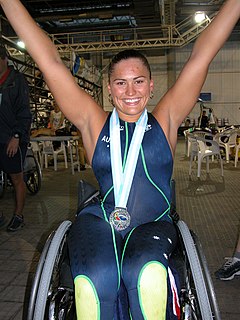 W
WS4, SB3, SM4 are disability swimming classifications used for categorising swimmers based on their level of disability. Swimmers in this class have coordination problems affecting all four of their limbs, or have movement in their arms but no trunk or leg function. They also generally have weakness in their hands and arms. A variety of disabilities are represented by this class including people with quadriplegia from spinal cord injury. Events this class can participate in include 50m and 100m Freestyle, 200m Freestyle, 50m Backstroke, 50m Butterfly, 50m Breaststroke, and 150m Individual Medley events. The class competes at the Paralympic Games.
 W
WS7, SB6, SM7 are disability swimming classifications used for categorizing swimmers based on their level of disability. Swimmers in this class have use of their arms and trunk. They have limited leg function or are missing a leg or parts of both legs. This class includes a number of different disabilities including people with amputations and cerebral palsy. The classification is governed by the International Paralympic Committee, and competes at the Paralympic Games.
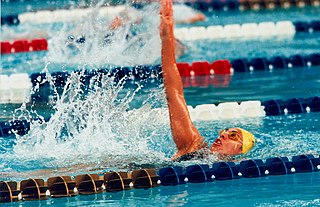 W
WS8, SB7, SM8 are disability swimming classifications used for categorizing swimmers based on their level of disability. This class includes a number of different disabilities including people with amputations and cerebral palsy. The classification is governed by the International Paralympic Committee, and competes at the Paralympic Games.
 W
WS11, SB11, SM11 are disability swimming classifications for blind swimmers.
 W
WS12, SB12, SM12 are disability swimming classifications used for categorising swimmers based on their level of disability.
 W
WS15, SB15, SM15 are disability swimming classifications used for categorising swimmers based on their level of disability. These classifications are for athletes with hearing loss.
 W
WT20 is a disability sport classification for disability athletics in track and jump events. It broadly covers athletes with intellectual disabilities.
 W
WT37 is a disability sport classification for disability athletics in track and jump events. It includes people who have coordination impairments such as hypertonia, ataxia and athetosis. It is the athletics equivalent of the more general CP7 classification.
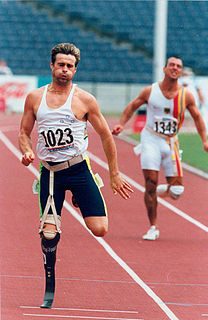 W
WT44 is a disability sport classification for disability athletics, applying to "Single below knee amputation or an athlete who can walk with moderately reduced function in one or both legs." It includes ISOD A4 and A9 classes.
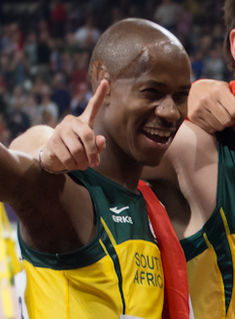 W
WT45 is disability sport classification in disability athletics for people with double above or below the elbow amputations, or a similar disability. The class includes people who are ISOD classes A5 and A7. The nature of the disability of people in this class can make them prone to overuse injuries. The classification process to be included in this class has four parts: a medical exam, observation during training, observation during competition and then being classified into this class.
 W
WT46 and F46 are disability sport classification for disability athletics. People in this class have a single below or above the elbow amputation. The amputee sports equivalent class is ISOD the A6 and A8 classes. People in this class can have injuries as a result of over use of their remaining upper limb. The classification process to be included in this class has four parts: a medical exam, observation during training, observation during competition and then being classified into this class.
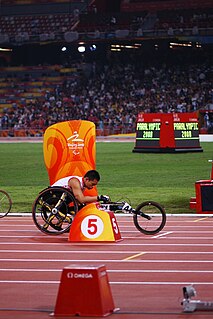 W
WT53 is disability sport classification for disability athletics. The class includes people with a number of different types of disabilities including spinal cord injuries. People in this class have full use of their arms but have no or limited trunk function. Similar classifications are T51, T52, and T54. People in this class have a functional upper limbs, but limited trunk usage and limited lower limb functionality. During classification, they both undergo a bench test of muscle strength and demonstrate their skills in athletics. People in this class include Tanni Grey-Thompson (GBR), Samantha Kinghorn (GBR), Angie Ballard (AUS) and Richard Colman (AUS).
 W
WT54 is a disability sport classification for disability athletics in the track and jump events. The class includes people with spinal cord injuries who compete using a wheelchair in track events. They have paraplegia, but have normal hand and arm function, normal or limited trunk function, and no leg function. This class includes CP-ISRA classes CP3 and CP4, and some athletes in ISOD classes A1, A2 and A3.
 W
WTandem is a para-cycling classification for cyclists that require a sighted pilot for a non-sighted rider. The UCI recommends this be coded as MB. PBS defined this group as "Athletes who are blind or visually impaired compete with no classification system. They ride tandem with a sighted “pilot.”" The Telegraph defined this classification in 2011 as "B: Athletes who are blind and visually impaired" British Cycling defines this classification as: "Blind or Visual Impaired (VI), TCB - from no light perception in either eye up to visual acuity of 6/60 and/or visual field of less than 20 degrees. Classification assessed in the best eye with the best correction. Classification will be provided by a UCI accredited classifier"